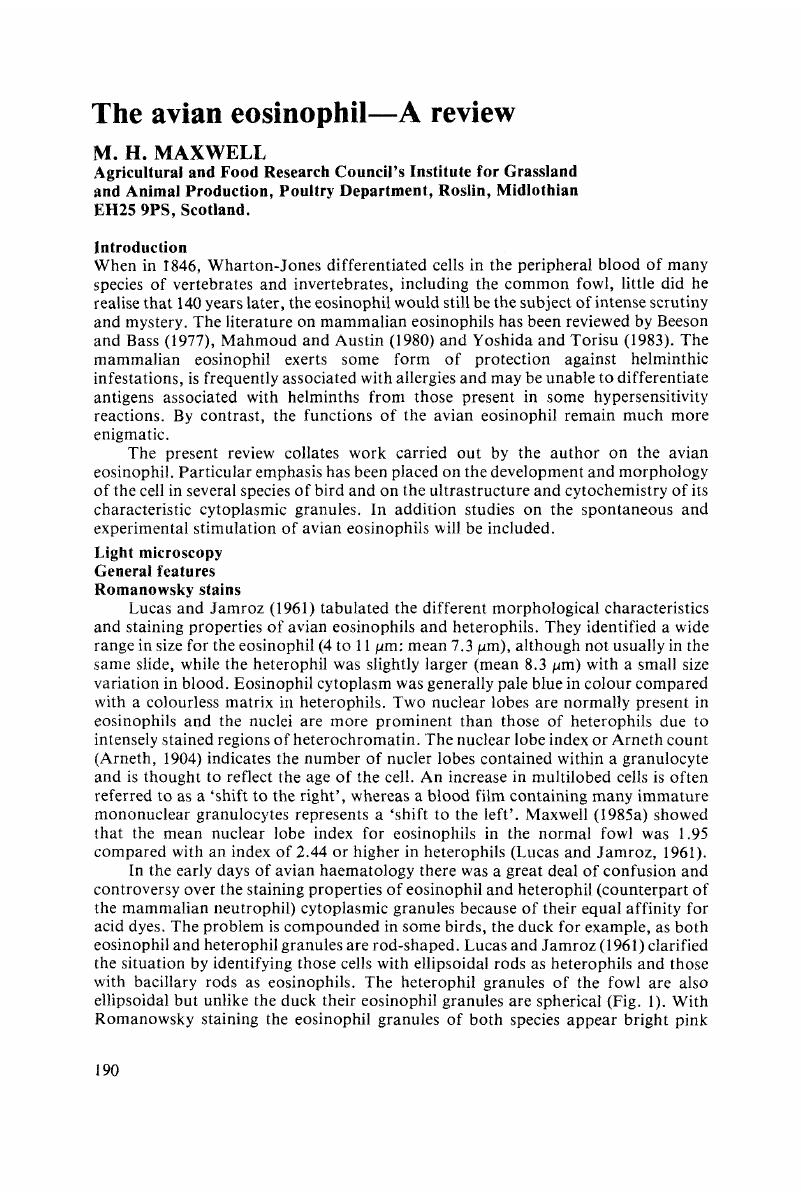Crossref Citations
This article has been cited by the following publications. This list is generated based on data provided by Crossref.
Jones, D.G.
1993.
The Eosinophil.
Journal of Comparative Pathology,
Vol. 108,
Issue. 4,
p.
317.
Maxwell, M.H.
and
Robertson, G.W.
1995.
The avian basophilic leukocyte: a review.
World's Poultry Science Journal,
Vol. 51,
Issue. 3,
p.
307.
Maxwell, M.H.
and
Robertson, G.W.
1998.
The avian heterophil leucocyte: a review.
World's Poultry Science Journal,
Vol. 54,
Issue. 2,
p.
155.
Lam, K.M.
2001.
Eosinophilia in Duck Embryos Induced by an Apathogenic Strain of Duck Enteritis Virus.
Journal of Comparative Pathology,
Vol. 124,
Issue. 4,
p.
313.
Kajerová, V.
Literák, I.
Bártová, E.
and
Sedlák, K.
2003.
Experimental infection of budgerigars (Melopsittacus undulatus) with a low virulent K21 strain of Toxoplasma gondii.
Veterinary Parasitology,
Vol. 116,
Issue. 4,
p.
297.
Post, J
Rebel, JM
and
ter Huurne, AA
2003.
Automated blood cell count: a sensitive and reliable method to study corticosterone-related stress in broilers.
Poultry Science,
Vol. 82,
Issue. 4,
p.
591.
Davis, A. K.
Maney, D. L.
and
Maerz, J. C.
2008.
The use of leukocyte profiles to measure stress in vertebrates: a review for ecologists.
Functional Ecology,
Vol. 22,
Issue. 5,
p.
760.
Abdul-Careem, M.F.
Hunter, D.B.
Thanthrige-Don, N.
Haghighi, H.R.
Lambourne, M.D.
and
Sharif, S.
2008.
Cellular and cytokine responses associated with dinitrofluorobenzene-induced contact hypersensitivity in the chicken.
Veterinary Immunology and Immunopathology,
Vol. 122,
Issue. 3-4,
p.
275.
Bonadiman, S.F.
Stratievsky, G.C.
Machado, J.A.
Albernaz, A.P.
Rabelo, G.R.
and
DaMatta, R.A.
2009.
Leukocyte ultrastructure, hematological and serum biochemical profiles of ostriches (Struthio camelus).
Poultry Science,
Vol. 88,
Issue. 11,
p.
2298.
Davis, Andrew K.
Keel, M. Kevin
Ferreira, Andrew
and
Maerz, John C.
2010.
Effects of chytridiomycosis on circulating white blood cell distributions of bullfrog larvae (Rana catesbeiana).
Comparative Clinical Pathology,
Vol. 19,
Issue. 1,
p.
49.
Dudek, K.
and
Bednarek, D.
2011.
Cellular immune response of pigeons in the conditions of endotoxin fever and pyrogenic tolerance.
Polish Journal of Veterinary Sciences,
Vol. 14,
Issue. 1,
p.
127.
Andrade, Josiana Gomes de
Carvalho, Eulógio Carlos Queiroz de
Santos, Clóvis de Paula
and
DaMatta, Renato Augusto
2011.
Mixed infection withLibyostrongylus dentatusandLibyostrongylus douglassiiinduces a heterophilic inflammatory infiltrate in the proventriculus of ostriches.
Avian Pathology,
Vol. 40,
Issue. 4,
p.
367.
Wojczulanis-Jakubas, Katarzyna
Jakubas, Dariusz
Czujkowska, Agnieszka
Kulaszewicz, Izabela
and
Kruszewicz, Andrzej G.
2012.
Blood Parasite Infestation and the Leukocyte Profiles in Adult and Immature Reed Warblers (Acrocephalus scirpaceus) and Sedge Warblers (Acrocephalus schoenobaenus) During Autumn Migration.
Annales Zoologici Fennici,
Vol. 49,
Issue. 5-6,
p.
341.
Fairn, Evan R.
McLellan, Nicolas R.
and
Shutler, Dave
2012.
Are Lice Associated with Ring-Billed Gull Chick Immune Responses?.
Waterbirds,
Vol. 35,
Issue. 1,
p.
164.
Cīrule, Dina
Krama, Tatjana
Vrublevska, Jolanta
Rantala, Markus J.
and
Krams, Indrikis
2012.
A rapid effect of handling on counts of white blood cells in a wintering passerine bird: a more practical measure of stress?.
Journal of Ornithology,
Vol. 153,
Issue. 1,
p.
161.
de Macchi, Barbarella Matos
Miranda, Farlen José Bebber
de Souza, Fernanda Silva
de Carvalho, Eulógio Carlos Queiroz
Albernaz, Antônio Peixoto
do Nascimento, José Luiz Martins
and
DaMatta, Renato Augusto
2013.
Chickens treated with a nitric oxide inhibitor became more resistant to Plasmodium gallinaceum infection due to reduced anemia, thrombocytopenia and inflammation.
Veterinary Research,
Vol. 44,
Issue. 1,
Wojczulanis-Jakubas, Katarzyna
Jakubas, Dariusz
Kośmicka, Anna
and
Jensen, Jens-Kjeld
2014.
Leg abnormalities and leucocyte profiles in the European Storm-Petrel (
Hydrobates p. pelagicus
) from the Faroe Islands
.
The Wilson Journal of Ornithology,
Vol. 126,
Issue. 4,
p.
739.
2015.
Exotic Animal Hematology and Cytology.
p.
37.
2015.
Exotic Animal Hematology and Cytology.
p.
235.
2016.
Avian Medicine.
p.
73.



